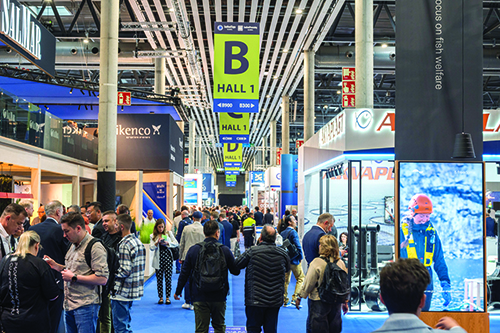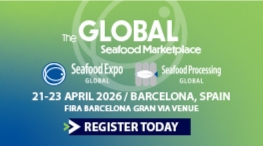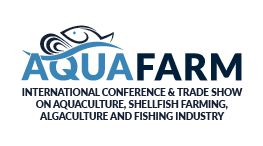Seafood Expo Global and Seafood Processing Global 2025, May 2025, Barcelona
This article was featured in Eurofish Magazine 4 2025.
The 31st edition of Seafood Expo Global and Seafood Processing Global, held from 6 to 8 May 2025 at Fira de Barcelona’s Gran Vía venue, reinforced its standing as the world’s foremost seafood trade exhibition. With over 2,100 exhibiting companies from 87 countries and more than 35,000 industry professionals in attendance, the event functioned not only as a marketplace, but also showed a sector being shaped by climate change, evolving consumer demands, and technological transformation.
Eurofish attended Seafood Expo Global with a stand as usual. This year the co-exhibitors were an association from Lithuania and a private company from Albania. Both partners expressed their satisfaction with the show as a networking platform as well as a source of inspiration for new products and services.
All stakeholders in the fisheries and aquaculture sectors represented
This year’s expo occupied 51,217 net square metres of exhibition space across six halls and the central gallery. The event brought together a broad spectrum of stakeholders: seafood suppliers, aquaculture technology firms, equipment manufacturers, -packaging specialists,- -logistics -companies, policymakers and researchers. A notable aspect of the 2025 edition was the addition of new national and regional pavilions as well as companies representing countries such as Egypt, Greenland and Nigeria, underlining the increasingly global scope of the seafood trade.
Major corporations exhibited alongside startups and regional producers, reflecting a wide industry cross-section. Companies showcased fresh, frozen, canned and value-added products, as well as the latest in seafood processing machinery, refrigeration equipment, traceability solutions and sustainable packaging. For Barcelona, the economic impact was projected to exceed €156 million, affirming the value of hosting such a concentration of international business activity.
Processing and innovation reduce waste
The Seafood Processing Global component of the event was especially -noteworthy this year for its focus on automation, sustainability and aquaculture technology. Companies presented -integrated systems for fish processing, hygiene management and cold chain logistics. These -innovations are increasingly essential as seafood producers seek to optimise efficiency and minimise waste. An encouraging trend was the attention given to resource upcycling. Crustalicious, a first-time exhibitor, presented products that use by-catch to produce premium crab meat. Similarly, Ocean Company focused on converting seafood by-products into usable ingredients. Neptune Elements’ seaweed-based food additives and teas signalled the growing commercial potential of algae as a sustainable resource. Such initiatives suggest that parts of the seafood industry are moving beyond sustainability rhetoric toward tangible innovations with commercial and environmental impact.
Sustainability and traceability feature at stands and conference interventions
Sustainability was central in both the exhibition and conference programming. Sessions covered issues such as decarbonisation, aquaculture’s environmental footprint, and resilient supply chains. Academic voices such as Ray Hilborn (University of Washington) added weight to discussions with data on climate impacts and biodiversity. Hilborn’s talk, Seafood in a Changing Climate, explored the causes and consequences of marine environmental shifts, including ocean deoxygenation and migration patterns. Another session led by representatives from the FAO and WTO introduced -updated -methodologies for assessing fish stock status—an effort to improve data quality and policy coherence in fisheries management. These topics reflected the increasing importance of -science-based approaches to sustainability in global seafood governance. While such discussions are valuable, the industry still faces challenges in translating conference insights into enforceable practices. Much of the conversation remains exploratory, signalling a need for stronger regulatory -alignment and more transparent monitoring frameworks.
A highlight was the keynote delivered by economist Xavier Sala-i-Martin from Columbia University. His talk, A New Uncertain World, placed the seafood sector within the broader economic context of trade tensions, inflationary pressures and geopolitical instability. By connecting global macroeconomic shifts with seafood’s role as a strategic commodity, Prof. Sala-i-Martin underscored the need for adaptability in global trade practices and supply chain design. Altogether, over 80 international speakers across 20 sessions blended technical, commercial, and policy-oriented content at the conference. Topics ranged from traceability technologies and packaging innovation to consumer trends and digital transformation. The presence of such a diverse speaker base helped position the expo not only as a commercial platform but as an arena for thought leadership and sector-wide dialogue.
Reflections and future outlook
Seafood Expo Global and Seafood Processing Global 2025 succeeded in bringing the global seafood community together at a time of heightened uncertainty and rapid change. From economic headwinds to environmental pressures, the seafood sector faces -complex and interrelated challenges that no single company or country can tackle alone. The Barcelona event demonstrated the industry’s appetite for innovation, from AI-driven aquaculture tools to seaweed-based consumer products. Yet, it also highlighted the threats from climate change, tariffs, trade wars, and international conflicts. The 2026 edition, scheduled for 21–23 April, will offer another opportunity to assess how the seafood sector copes with these challenges and whether investments in international collaboration, innovation, and green initiatives will result in a more resilient industry.









